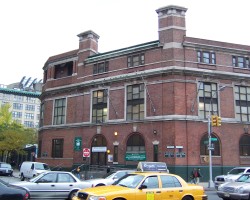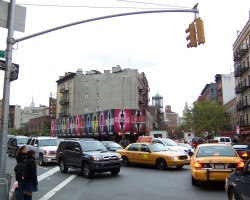83 Carmine Street Public Bath
Opened: 1908
Cost: $210,144
The Carmine Street Public Bath was built to serve what was then one of New York's numerous "Little Italy" neighborhoods of Italian immigrants. The bath was built in what was then Hudson Park, which had been built on land that has been a cemetery for Trinity Church from 1812 to 1895. The park originally featured an elegant design by Carrere and Hastings, although most of that design has been lost in adaptations for expanded recreational use in 1903, 1935 and a complete paving in 1946. In 1947, the City Council renamed the park for James J. Walker, a colorful early 20th century mayor who had grown up in the neighborhood. (historical sign)
The building was designed by the firm of Renwick, Aspinwall and Tucker and featured showers and tubs on the first two floors, a gym on the third floor and an open air classroom for sickly children on the roof. The gym was updated in 1911 for weight-lifting and basketball. An indoor pool was added in 1920, altering the eastern facade. The Department of Parks assumed full jurisdiction over the bathhouse in 1938 and added an WPA-built outdoor pool in 1939. In 2004, the Carmine Recreation Center was renamed the Tony Dapolito Recreation Center after a neighborhood community board member and parks committee member who lead the successful battles to save Washington Square Park and the entire So Ho neighborhood from the ill-conceived highway plans of city planning despot Robert Moses. (historical sign)
Although originally addressed as 83 Carmine Street, the current address of the building is One Clarkson Street and it sits on the corner where Clarkson, Carmine, 7th Avenue and Varick Street meet. This area of what is now the West Village was one of the last irregular street networks plotted before the grid plan of 1811 imposed numeric order on new streets further North. In 1913 (after the bath house was already in operation), the city made a decision to extend Seventh Avenue to make construction of the IRT subway line (now the 1/2/3 train) easier and to satisfy real estate agents who wanted a wider North-South thoroughfare through the area to increase property values. The Seventh Avenue Extension cut a 100-foot wide path through the already-developed area, resulting in destruction of 194 buildings and the displacement thousands of residents while opening easier access to a neighborhood that had previously been rather quiet and isolated.

